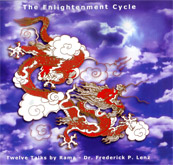
The Enlightenment Cycle
Power
Power. Power is the active force in life. It is the force of life that makes awareness.
Power is seen in the wind, in fire, in movement - physical movement, emotional movement, mental movement. Power is awareness. Power in Buddhism is defined very precisely in many different ways. There is no singular word that can encompass all the different aspects of power. The general term for power, spiritual power, the power of awareness, is kundalini. Kundalini is the energy of life that creates life. Life is awareness. It is movement. It is sentient.
Life is the power to perceive. Without perception, there is no life. Types of perception certainly vary. Plants have one kind of perception, amoebas another, birds another, human beings another, astral beings another. The universe itself is a giant perceptual matrix. It perceives itself in essence and through its substance. Buddhism, yoga, is the study of perception, and what is most endemic to perception is power - the power to exist, to perceive, and the power to change perception.
Perception defines everything. I may be sitting in a room and looking around, and I'll perceive the room in one way. Another person may be sitting in the same room and they will perceive the room in an entirely different way. They may have had a bad day - they're depressed, anxious, restless, and they don't enjoy being in the room at all. I may be sitting in a room very happy, maybe something great just happened, or maybe I'm just feeling good and the room is gorgeous. Its colors seem bright; the texture of the rug is vivid. The other person may not even notice these things. Their perception may be memory. Perhaps they're living right now in something that occurred earlier in the day that was unpleasant - maybe a confrontation with someone they knew well that was unpleasant.
So perception really varies. In other words, it's internal. Perception is emotive; it is mental; it has to do with thoughts. But it is, in its essence, what we are. That is to say, in a certain way we are what we perceive. Or you might say, what we perceive certainly defines what we are. Now, we have to think of life in reverse. If we are perceiving other than what we are, if perception is the awareness of other, certainly, perhaps in a sense, perception can be the awareness of oneself. But if, primarily, the way we view the universe is the universe as other than what we are, perception is a mirror. In other words, we are everything that we don't perceive.
All perception is a background. It's a screen through which we can see ourselves. Perception is the ability to become conscious of self and that which is other than self, and other than self is normally what we perceive - what you call the external universe. Who are we? Well, we are the being that perceives. And certainly without thinking about it, a distinction is made between who we are and what we perceive. We perceive that which is other and that which is self.
Power is the band that we perceive things on. In radio we have AM stations, FM stations, short wave stations and others. They're frequencies; they're megahertz, kilohertz - they vibrate. Frequencies vibrate at specific rates, and within those frequencies we transmit information and receive information. Perception is made up of bands. It's a way of talking about it. And the bands of perception vary greatly. There's the human band of perception and the mammalian band of perception that would include all mammals. There is the plant, invertebrate, and so on. There's lots of different bands of perception, and simply because we are in one band of perception and aware of it doesn't mean others are not there.
We may be listening to FM stations. That may be all we listen to. But thousands of AM stations are on the dial just a few vibrations away. Experiences are being had, people are transmitting information, listening to music, gathering information. So it's just good to remember that the human field of perception is not in any way the only field of perception, the only band of perception. Nor is it necessarily the best. There is no such thing in infinity. Everything is the best, I suppose you might say. Infinity doesn't label - its creations are not labeled, they just are. Human beings like to label things and we like to say, "This is better than that; this is more pleasing; this is less pleasing" - according to our sensorial system or our mental or emotional system or philosophical, sociological or political systems or religious systems.
So power, to begin with, is the thing that holds a band of perception together, and a band of perception is life for those who perceive in that band. If that band of perception were to go away, they would not exist. There are many great bands of perception in the universe. There are both organic and inorganic bands of perception. Today we're confining ourselves to the organic band of perception, specifically to the human band of perception. But I just want you to know that it is possible to modify your awareness field so you can perceive what plants perceive, what birds perceive, what beings in the astral perceive, what beings in the causal perceive.
There are many universes, many dimensions. They are endless. And it is possible to gain entry to those perceptual fields. Most of them are not particularly relevant for us. They won't help us. They won't make us happier. We won't gain knowledge or information or power that we can use to improve the quality of our lives. They simply don't reference it. There have been people who have classified and categorized these bands in different yogic systems. They enjoy [this] - just as a botanist might enjoy classifying plants. It gives them some pleasure to create names and orders and to make catalogs. Human beings like that.

